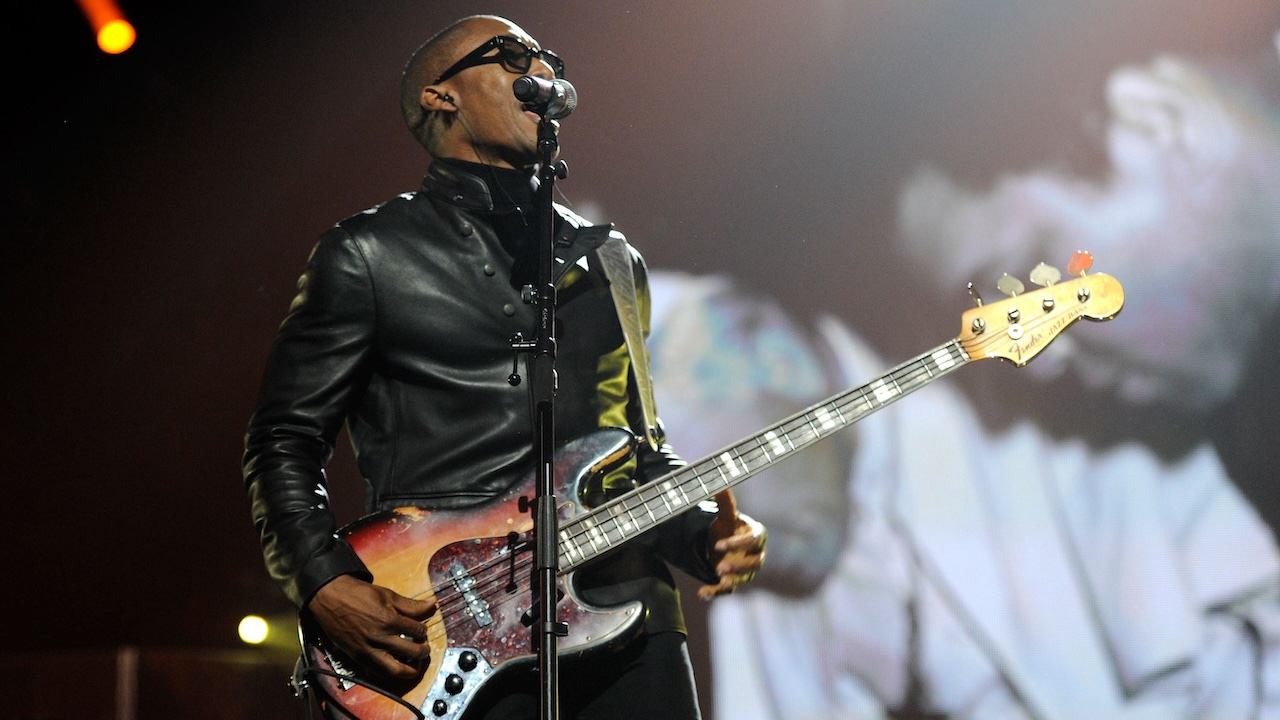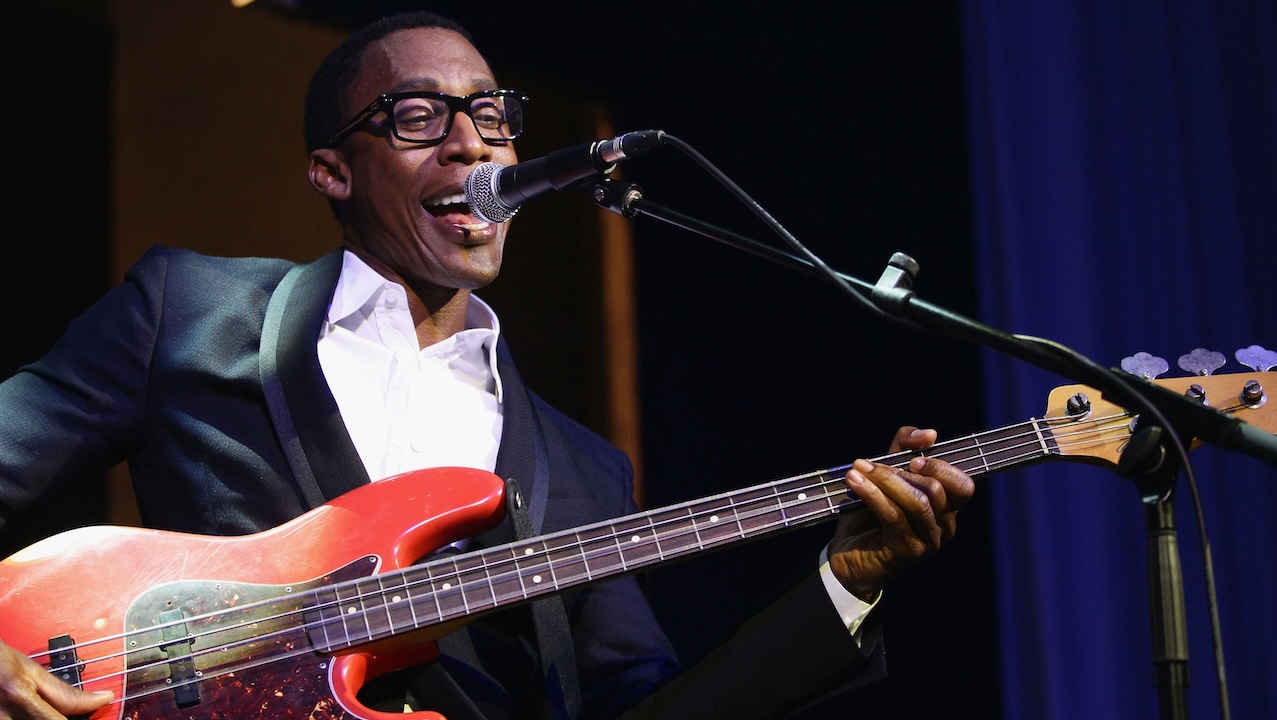
As hip-hop continues to influence styles ranging from R&B to heavy metal and beyond, the musician-meets-machine concept is being played out in various ways. Few of these approaches are more cutting-edge than that of Raphael Saadiq, who merged hip-hop's programmed approach with his old-school R&B roots to create a whole new rhythm section style.
Offers Glenn Standridge, one half of Saadiq's production team: “When we're creating tracks, everyone sort of plays to their own beat, with everything revolving around Raphael's bass guitar – so it has that loose, hip-hop quality of samples layered together. The result is a best-of-both-worlds scenario that creates a feel all its own.”
Probably the best-known examples of Saadiq's postmodern potion are his groove-breaking collaborations with neo-soul crooner D'Angelo, and Lucy Pearl.
Guitar was actually the first instrument Saadiq (born Raphael Wiggins) played in his native Oakland, California. After hearing James Jamerson's upright on Marvin Gaye's How Sweet It Is (To Be Loved by You), he asked for an Orlando Jazz Bass copy at age seven. With a quick ear, he soon graduated from jamming with family and friends to having his pals ask if he could sit in with them at clubs.
Paying gigs soon followed, with days spent playing trombone in the junior high school jazz band and bass in U.C. Berkeley's Youth Music Program. “I was constantly playing in all kinds of settings,” Saadiq told Bass Player. “I'd go into coffee houses and just improvise grooves behind rappers or poetry readings.”
In the mid 1980s, while the 18-year-old Saadiq was putting together demos with his brother D'wayne Wiggins and cousin Timothy Christian Riley (for what would eventually become Tony! Toni! Toné!), a friend called to tell him Sheila E. was coming to the Bay Area to audition singing bassists for her touring band. Saadiq beat out 40 other hopefuls, and a month later he was opening for Prince.
In 1988, the “Tonys” were signed, and Saadiq began his own musical quest.
Saadiq’s prized 1962 Fender Precision put the vintage in his 2002 solo debut, Instant Vintage, which also featured hip-hop heroes D'Angelo, Angie Stone, and the Tower Of Power Horns.
“I've never heard another bass guitar like it,” marveled Glenn Standridge, who with partner Bobby Ozuna makes up Saadiq’s production team of Jake & the Phatman. “Between the foam under the bridge cover and the old Rotosound strings, it's so dead you can't even play it live.
“We tried at one soundcheck – you couldn't even hear a tone, and there was no pop at all. But in the studio, with Raphael's touch, it's a killer!”
Elsewhere, Saadiq played his '90s Fender Jazz, an '80s Ibanez Musician on Charlie Ray, and his Ransom 5-string “flag bass” on Be Here.
His studio amp was an SWR Silverado Special combo. His outboard effects included a Big Briar MF-101 Moogerfooger Lowpass Filter, a ProCo Rat distortion pedal, and a Dunlop Cry Baby Bass Wah.
The following interview from the Bass Player archives took place in 2002.
What are your reflections on Lucy Pearl?
“That project got me back in touch with my goals after having taken a long break from music. But it was a group situation, and sometimes when you pass the ball to people they don't finish the shot, so you realise you should have taken the shot in the first place. In retrospect, it was a helpful step toward going solo and recording Instant Vintage, which is something I should have done sooner.”
One of your trademarks is a super-laid-back-feel.
“I don't have a name for it; it's sort of like ghosting or shadowing the snare drum. I'm locking with the drums, but a step behind, kind of sneaking up on them. You hear the snare hit and then I ghost or echo that. But for it to work, the drummer has to be aware of what I'm doing, and stay right in the middle of the beat, to keep that rubber-band-like tension.”

“It's hard to learn, especially for people who always play on top, but you could practice it by setting up a drum loop with a two and four snare. First play a quarter-note or eighth-note pattern that locks with the loop, and then gradually pull back until you're ghosting the snare by playing a split-second after it hits.”
Does this approach have hip-hop roots?
“It came about when D'Angelo and I first played together. We just started doing it, and the more we laid back, the more we'd laugh. That's the way D sings and plays, but it's something we both felt naturally; I don't think he did it with anyone else. When he got his road band together, he found Pino Palladino and Ahmir Thompson who could do it well, but they're some of the few who can.”
On Charlie Ray you apply what you call “the grease.” What is that?
“I get it with my thumb plucks; it's when I don't play any real pitches – just dead notes with a lot of percolating in between rhythms. I use it on other tracks, but it's hard to hear at times. It's sort of like what Larry Graham and Prince do on bass. People think Larry used left-hand pats, but he pretty much did everything with his thumb, using up- and downstrokes.”
What was your concept for Instant Vintage?
“I wanted to have a record that entertains, and would appeal to a wide array of listeners without losing the integrity of what I learned as a musician. I tried to make every song a bit different from the next, and I wanted each one to feel like a single – along the lines of what Michael Jackson and Quincy Jones did with Off the Wall, where every song had an impact.”
Throughout the album, your bass is the main voice.
“It's the centerpiece. When I record, I almost always put down the drums and guitar first and then the bass. I like doing the bass and vocals together because they feed off each other; I get my vocal part from the bass and vice versa. I'll give the bass its own space and then sing around that, like on Body Parts, so each one stands out as a melody or they call and answer with each other.”
Jake & the Phatman say your “independent parts” approach is a key to your hybrid sound.
“I play a lot of everything on the record – bass, some guitar, a bit of keyboards, plus the vocals – so as a kind of one-man band I have to do it that way. When we put it all together, it can sound like everything is sampled because my parts aren't in perfect time.
“I also enjoy playing in a different pocket space than the drums, like on Skyy, Can You Feel Me. Raymon Murray came up with a drum groove, and then I added a bass part that's completely counter to it.”
Sonically, you tend to EQ and place the bass differently from track to track.
“How it sounds and where it sits is a big part of the feel, aside from notes and phrasing. Sometimes I pan the bass front and center, and sometimes it's to the left. Likewise, at times I'll go for rumbling, earthy lows, or if I'm doing a lot of muting we'll have less lows and more mids. It's always different.”
Can you describe your techniques?
“I learned to slap first, because as a kid I didn't have the forearm strength to finger-pluck. I don't slap much anymore because it's not the thing right now. I do a lot of what I call thumb-plucking: holding my thumb parallel to the strings, I use the meat of my thumb on the downstroke and top side of my nail on the upstroke. I can mute to varying degrees with my fingers or palm.”
What did you learn while playing live with Prince?
“Mainly, how to play all night long, and also the power of simplicity. One night we were playing funk in E, and he went over and picked up my bass – but it was tuned to Eb, so he just found one note that worked, and he stayed on it the entire song and drove the groove home.”




!["[T]he First and Fifth Amendments Require ICE to Provide Information About the Whereabouts of a Detained Person"](https://images.inkl.com/s3/publisher/cover/212/reason-cover.png?w=600)


